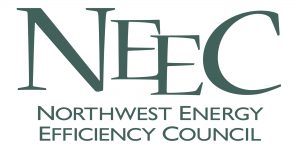Stan Price, NEEC Executive Director, was quoted in the recent Puget Sound Business Journal that “Talking about it isn’t as stimulating as spending it.” Here is an update on how close the state’s are to spending it.
Washington: Local communities have submitted their block grant plans to US DOE and hope to hear approval by early Fall. Cities and counties of sufficient population get direct grants through the EECBG program and many communities have submitted plans for energy efficiency upgrades for residential and public buildings. The low income weatherization funds should be hitting the streets very soon as DOE released the first round of funds to the states in July. This program is administered by the Department of Commerce (CTED) primarily through local community action agencies. At the state level, competitive solicitations have been issued for three community based weatherization projects, administered by WSU Energy Extension, and for a grant and loan program through the Department of Commerce.
Oregon: As with all states, Oregon has both community level block grants available (plan approval’s still pending) as well as state directed opportunities. At the state level, Oregon’s SEP plan states;
The Oregon Department of Energy’s overall strategy is to use ARRA SEP funding for an estimated 200 energy efficiency and renewable energy projects on public buildings, and to look for opportunities to leverage these funds for innovative projects/programs/initiatives that address state energy priorities and have high potential for achieving the ARRA SEP goals. A focus on public buildings allows ODOE to most effectively use its existing expertise and programs to efficiently expend ARRA SEP funds, while also providing an opportunity for government to take a leadership role in demonstrating innovations in energy efficiency and renewable energy. The Oregon Department of Energy will be administering the process.
Idaho: The Idaho Office of Energy Resources has selected ten engineering firms to provide scoping audits on all Idaho K-12 classrooms. It is anticipated that the 38 million square plus feet will be audited over the next several months. A pilot scoping audit and tune-up will be finalized within the next week. Total energy building energy savings between 10 and 15 percent are anticipated. The Idaho State Department of Education anticipates reinvesting the millions of dollars saved on utility bills in academics. “Ultimately the cost savings from energy efficiency improvements means more money can be spent in the classroom,” said Melissa McGrath, a spokeswoman for the Department. The Office of Energy Resources estimates that the project will create 150-250 new jobs in Idaho over the next three years. The jobs will be primarily in the heating and cooling, lighting, insulation and water efficiency industries. (Contributed by Ken Baker and Jessica Adams)
